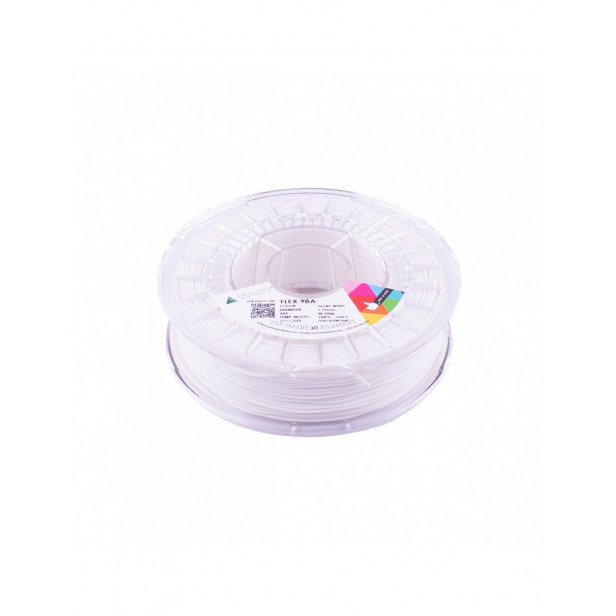Smartfil TPU Flexible 98A Filament – Easy 3D Printing
Filament 1.75mm black flexible and elastic for 3D printer. Made in Spain
330-750g
Te quedan 120€ para el envío gratis

24h Delivery

FREE for orders over 120€

Secure payment
Información del producto
FEATURES – SMARTFIL FLEXIBLE FILAMENT 98A SPOOL:
- Material type: Polyurethane (TPU – Thermoplastic Polyurethane)
- Material property: Flexible
- Filament color: Black – True Black / White – Ivory White
- Filament diameter: 1.75 mm
- Mechanical properties:
- Hardness: 98 Shore A
- Printing parameters:
- Extrusion temperature: 220 – 240 ºC
- Bed temperature: 0 – 60 ºC
- Cooling fan: 60 – 80%
- Flow rate: 100%
- Layer height: ≥ 0.1 mm
- Nozzle recommendation: ≥ 0.2 mm
- Print speed: 20 – 35 mm/s
- 98A TPU filament properties:
- Flexible
- Impact-resistant
- Net weight: 750 g
- Gross weight: 975 g
- Brand: Smartfil
- Manufacturer: Smart Materials 3D
- Made in: Spain
APPLICATIONS OF SMART MATERIALS 98A FLEXIBLE FILAMENT FOR 3D PRINTERS:
If you want to print flexible parts, this is your filament. The most common 3D-printed objects made with this filament include:
- Footwear
- Car parts
- RC components
- Handles and grips
If you want to learn more about flexible filaments, click here.
What is TPU?
TPU stands for Thermoplastic Polyurethane. It is highly flexible, elastic, and soft, making it ideal for shock-absorbing and vibration-dampening applications, thanks to its resistance to impact.
The market typically offers flexible filaments such as TPE and TPU (a type of TPE). When choosing between them, pay attention to the Shore hardness. TPU filaments are generally stiffer than TPE, which means TPU is easier to print with on most 3D printers.
What are the properties of a flexible TPU filament?
- Recommended for vibration and shock dampening applications.
- Resistant to impact and deformation.
- Performs well under low and high temperatures.
- Resistant to many chemicals.
- Returns to its original shape after stress (elastic recovery).
What are the disadvantages of printing TPU with a 3D printer?
The main difficulty with TPU is its printability. It is not as plug-and-play as PLA. It requires fine-tuning and patience to achieve perfect results.
Another downside is that it doesn't allow easy post-processing compared to stiffer materials.
What makes Smart Materials’ TPU flexible filament unique?
Smart Materials developed a filament that maintains high flexibility without compromising ease of printing. Keep in mind: the more stretchable and elastic the filament (i.e., greater elongation before break), the harder it is for the extruder to push it through the nozzle consistently—especially on Bowden setups.
How do you measure the hardness or flexibility of flexible filament? What’s the difference between Smartfil 93A and 98A?
Shore A hardness applies to soft elastomers, while Shore D is used for harder materials. The Shore scale runs from 0 to 100—the higher the number, the harder the material.
So, 98A is harder and less flexible than 93A. 93A filaments compress and deform more easily under pressure.
What is Smartfil 98A filament best used for?
This filament was developed with orthotic and protective applications in mind. It meets the need for parts that are durable, slightly flexible, and impact-resistant—ideal for orthotic protectors and prosthetic shells that must not crack or deform easily.
MANUFACTURER'S PRINTING RECOMMENDATIONS:
This product is hygroscopic. Store it sealed in a cool, dry environment to ensure performance over time.
- Ensure continuous extrusion: TPU can be difficult to print at first. Adjust your settings gradually until you get a stable and smooth flow. Use hairspray or bed adhesive to improve bed adhesion.
- Set the right temperature: Each printer behaves differently. The recommended extrusion temperature is 225 °C (range: 215–235 ºC). Higher temps reduce clogging risk, but too hot may damage print quality.
- Slow print speed: Unlike PLA or ABS, TPU doesn’t tolerate fast printing. Use speeds of 35 mm/s or less for reliable output.
- Top layer height: 0.2 mm
- If possible, disable retractions to avoid jamming in the extruder.
You might also like
Más productos de Smart Materials 3D




















